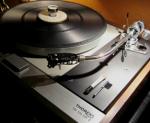An L-pad is (normally) a three terminal device that is functionally the same as the picture below where one terminal is the "+", one is the R1-R2 junction, and the other is the "-" ... the difference being the circuit below has R1 and R2 fixed, where an L-pad allows for them both to be adjusted while it's knob is rotated. If you want to replace an L-pad with fixed resistors and have a good L-pad that's set where you like, just measure the resistance between terminals. Of the three possibilities, you'll get R1, R2, or R1+R2... double check this with a calculator like the one below to see that it makes sense.
For an 8 ohm L-pad: At one extreme R1 should get close to 8 ohms and R2 very small. At the other, R1 should be minimal and R2 perhaps tens to hundreds of ohms.
sourced from
https://www.erseaudio.com/L-Pad-Attenuation ... one of many such online audio L-pad calculators.

See also:
http://www.bcae1.com/lpad.htm





 Reply With Quote
Reply With Quote


